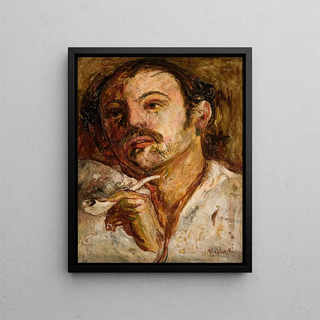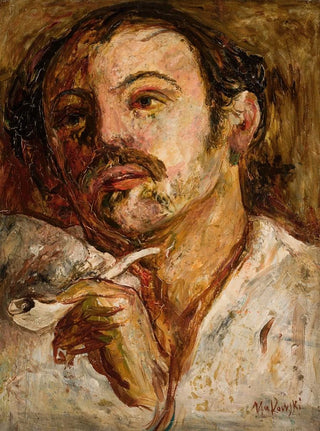Art print | Portrait of a man smoking a pipe - Tadeusz Makowski Source: Reproduction | Portrait d'un homme fumant une pipe - Tadeusz Makowski


View from behind

Frame (optional)
In the fascinating world of art, some works manage to capture the very essence of humanity through simple gestures and profound expressions. "Portrait of a man smoking a pipe" by Tadeusz Makowski is one of those creations that, through its depth and intimacy, transports us to a suspended moment in time. This painting, both mysterious and evocative, invites the viewer to delve into the introspection of the character, revealing layers of meaning that go beyond the simple act of smoking. The piece, imbued with a warm and melancholic atmosphere, prompts us to question the nature of the thoughts crossing this man's mind, while offering a poignant glimpse into the human soul.
Style and uniqueness of the work
Makowski's style is distinguished by a rich color palette and a painting technique that combines precision and expressiveness. In "Portrait of a man smoking a pipe," shades of brown and ochre create a warm ambiance, while subtly placed shadows bring the face of the character to life. Every brushstroke seems charged with emotion, and the artist manages to convey an atmosphere of calm and reflection. The relaxed posture of the man, associated with the object of the pipe, evokes a moment of contemplation, almost philosophical. This painting does not merely depict a scene; it invites reflection on time, solitude, and the search for meaning. The way Makowski plays with light and shadow further emphasizes the psychological depth of the character, making this work a true masterpiece of human expression.
The artist and his influence
Tadeusz Makowski, a Polish artist of the early 20th century, established himself as an emblematic figure of the expressionist movement. His ability to capture the essence of human emotions through intimate portraits marked his era and continues to influence contemporary artists. Makowski grew up in a rich cultural context, nourished by influences from the Polish pictorial tradition as well as European artistic currents of his time. His work, although deeply rooted in his cultural heritage, transcends the

Matte finish

View from behind

Frame (optional)
In the fascinating world of art, some works manage to capture the very essence of humanity through simple gestures and profound expressions. "Portrait of a man smoking a pipe" by Tadeusz Makowski is one of those creations that, through its depth and intimacy, transports us to a suspended moment in time. This painting, both mysterious and evocative, invites the viewer to delve into the introspection of the character, revealing layers of meaning that go beyond the simple act of smoking. The piece, imbued with a warm and melancholic atmosphere, prompts us to question the nature of the thoughts crossing this man's mind, while offering a poignant glimpse into the human soul.
Style and uniqueness of the work
Makowski's style is distinguished by a rich color palette and a painting technique that combines precision and expressiveness. In "Portrait of a man smoking a pipe," shades of brown and ochre create a warm ambiance, while subtly placed shadows bring the face of the character to life. Every brushstroke seems charged with emotion, and the artist manages to convey an atmosphere of calm and reflection. The relaxed posture of the man, associated with the object of the pipe, evokes a moment of contemplation, almost philosophical. This painting does not merely depict a scene; it invites reflection on time, solitude, and the search for meaning. The way Makowski plays with light and shadow further emphasizes the psychological depth of the character, making this work a true masterpiece of human expression.
The artist and his influence
Tadeusz Makowski, a Polish artist of the early 20th century, established himself as an emblematic figure of the expressionist movement. His ability to capture the essence of human emotions through intimate portraits marked his era and continues to influence contemporary artists. Makowski grew up in a rich cultural context, nourished by influences from the Polish pictorial tradition as well as European artistic currents of his time. His work, although deeply rooted in his cultural heritage, transcends the






